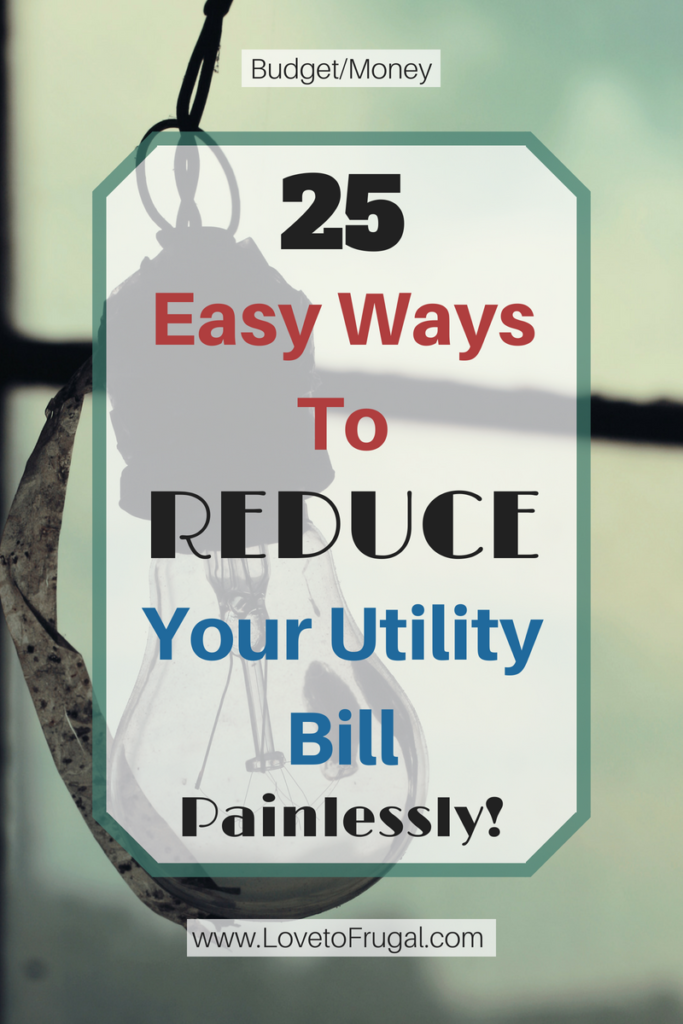How To Save Money On Utilities, Painlessly!
If you want to save money on utilities, there are some relatively painless things you can do to get started, right away.
Normally, it’s the summer that causes most of our utility bills to soar, but after the crazy, frigid temperatures we recently suffered through, many of us are experiencing drastic hikes in our electricity bills, way before the heat of Summer.
We would all love to know how to save money on utilities, but you probably think that that’s an expense that you just have to live with and that there’s no way of getting around these sky rocketing cost. If you believe this to be true, well…I’m going to tell you, that’s simply not true!
Like groceries, this is one household expense that you have some control of! Sure! It’s going to take some diligence, on your part, but changing some living habits and maybe even spending a little money can make the savings so worth it, in the long run.
If you’ll just hang with me for a few minutes, I’m going to let you in on some awesome, frugal tips on how to save money on utilities!
*This post may contain affiliate links. For more information, see my disclosure page.
Get Your Checklist!

Save money with your Free Energy Saving checklist! BONUS: Receive my newsletter that is full of money saving tips & tricks!
How To Save Money On Utilities…Painless & Simple!
1. USE A SOLAR DRYER
This is just a fancy term for line drying. I’ve done this for years, because I’m weird and I actually enjoy hanging clothes. Besides that, I have found that the clothes actually dry faster on the clothesline than in the dryer. Sometimes, depending on the size of the load, I have to run my dryer twice. That’s certainly not cost effective when you need to save money on your utilities.
How much does line drying actually save? Mr. Electricity reports that if you run 7.5 dryer loads per week and have a $0.15 per kWh rate from your electric company, you’ll save just shy of $200 per year by air-drying your clothes.
Other benefits of line drying include:
- Less wear and tear on the clothes, which means they’ll last longer.
- They smell better and line drying eliminates the need for dryer sheets.
- The UV rays from the sun are an natural brighter and disinfectant.
- It gives you a few minute break to get outside and soak in some good ole’ vitamin D! If you can’t have an outside line, hanging them inside will work, too. It may (or may not) take a little longer to dry.
2. WASH CLOTHES ON COLD
Very simply…washing clothes on cold saves energy, saves your clothes and saves money. Here’s an interesting article from ColdWaterSaves.org that breaks it down for you and also dispels the misinformation floating around out there that says using warm/hot water is the only way to get your clothes clean. That’s simply not true.
3. ADJUST THE WATER HEATER
Save some dough (and your skin) by dialing the temperature down to 120°F. For every 10-degree reduction, you’ll lower your bill $12 to $30 a year, the Department of Energy reports.
4. INVEST IN A TANKLESS WATER HEATER
We have one and we love it! We never run out of hot water. Tankless units (also called “on demand” units) heat water only when you turn on the faucet. The main advantage is that they eliminate the extra cost of keeping 40 to 50 gallons of water hot in a storage tank, so you waste less energy and save money.
5. USE LESS WATER
Did you know that the average American household use 140-160 gallons of water a day? There are a few simple, cost saving steps you can take to reduce your usage and save on the water bill:
Store cold water in the fridge.
Instead of running the tap and waiting for the water to cool off each time you want a cold each time you want a glass of water, fill up a pitcher or two and store them in your refrigerator. This works well if you use a pitcher with a water filter attached.
Don’t let the water run when shaving or brushing your teeth.
If you do this, it’s a complete waste of water. To rinse off your razor while shaving, just keep a cup of hot water next to you and dip it in every so often. When brushing your teeth, fill up a rinse cup and turn off the faucet.
Take shorter showers.
By reducing the time you shower by just four minutes, you can save almost 4,000 gallons of water per year. This can save as much as $100 on an annual basis and may help you save money on other utility bills, such as gas and electricity.
Run full loads of dishes and laundry.
If you load your dishwasher properly, you’ll fit in as much dishes as possible. Running it only when it’s full reduces the number of times you need to run it. Likewise, to save water when doing laundry, only run the washer when you have a full load of dirty clothes.
Install a low-flow shower head.
Installing a Low flow showerhead can reduce the amount of water you use while showering by as much as 50 percent.
Don’t hand-wash dishes.
Fix Leaky faucets ASAP!
6. TURN OUT THE LIGHTS!
This is a super, simple task. When you leave a room, flip the switch. Not a lot of thought or effort needs to go into this. The kind of bulbs your using can also make a big difference in how much leaving the lights on will cost you. Mr. Electric goes into detail of the efficiency and cost of each type of light bulb, with incandescent being the least efficient and most costly. If you’d like to know more, check out “How Much Money You Can Save By Turning The Lights Off”.
7. ONLY AC/HEAT THE ROOMS YOU USE.
This may be easier to do if you’re an empty nester or you have parts of your home, like a basement or extra bedrooms, that don’t get much traffic. We have 2 extra bedrooms that we have shut the vents off to and we keep the doors closed. When we have over night guest, we open the vents up.
Another way to save during the Summer months is raising the central air temperature at night and using a portable, dripless AC unit in the bedroom. It vents out of a window and is extremely efficient in keeping the bedroom cool as a cucumber. They’re about $499 at most home improvement stores, but you can recoup the cost fairly quickly with the savings on your electric bill. During the winter, when we don’t need it, it’s small enough to be stored in a closet.
In the Winter, we turn the heat way down and put an extra blanket on the bed at night. During the day, put on a sweater.
8. MAINTAIN YOUR HVAC UNIT.
We all know for a fact that things usually go wrong at the worst times and there’s nothing worse than your HVAC unit crapping out in August…in Texas. You know…when the temps hit 105 degrees. So, an ounce of prevention is worth a pound of cure…so to speak. Give your AC a check up once a year, preferably before the heat sets in. If you wait, you may be waiting a while for service. Summertime is the air conditioning man’s busiest time of year. And, what’s more, it’s going to cost you…a lot.
9. CHANGE YOUR AC FILTERS REGULARLY.
This would seem like a no-brainer, but you’d be amazed at how many people forget to do this simple and very inexpensive task. They need to be changed every 3 months to keep your system from having to work so hard. If you have a hard time remembering, mark it on your calendar when it needs to be done.
10. TURN THE AC UP AND THE HEAT DOWN WHEN YOU’RE NOT HOME.
I mean, let’s face it…if you’re not home, the temps don’t have to stay where they would be if you were home.
The Department of Energy estimates savings of about 1 percent for each degree of thermostat adjustment per 8 hours, and recommends turning thermostats back 7 to 10 degrees from their normal settings for 8 hours per day to achieve annual savings of up to 10%.
During colder weather, try keeping your thermostat at 68 degrees while people are home and awake but turning it down by up to 10 degrees while everyone is sleeping or away. In warm seasons, shoot for 78 degrees and push it up to 85 degrees when no one is home. According to the Department of Energy’s analysis, homeowners who do this will save an average of $83 per year.
Some people opt for turning the unit off completely. That would definitely save much more money, but if you have pets inside, this may not be a wise move. They should, however, be comfortable by raising/lowering the temps listed above.
If you have trouble remembering to adjust your thermostat, investing in a programmable one may be your solution.
11. KEEP THE CURTAINS CLOSED.
In the Summer, this helps to keep the heat out during the day. During the Winter, they’ll keep the heat in. Blackout, thermal and insulated curtains can do wonders for this and are relatively inexpensive.
12. INSTALL DIMMER SWITCHES.
Light dimmers save energy by reducing the flow of electricity to the bulb and allowing lights to operate with lower power outputs. Since lights under less stress shine longer, dimmers are known to extend the life span of your bulbs, too.
But, if you’re planning to keep the lights down low 24/7, simple math suggests that you should opt for low wattage lights instead. Low wattage light bulbs use less energy at full power than dimmed high wattage lights.
13. USE FANS!
A fan uses about the same amount of electricity as one standard light bulb. This includes ceiling fans.
14. RUN CERTAIN APPLIANCES AT NIGHT.
This includes your dishwasher, washing machine and dryer. Depending on where you live, many utility companies will charge higher rates during peak hours during the day. Once night rolls around and everyone turns their lights off and stops watching TV, their rates go down. Check out your bill or utility company’s website to find the posted rates for peak and off-peak hours. Simply running your dishwasher at night instead of during the day can save money on utilities such as electricity, gas, and water costs.
15. CHECK YOUR WEATHERSTRIPPING.
Where ever you can see, or feel air moving, there’s a gap and you’re losing your warm (or cooled) air to the outdoors. Weatherstripping can be added to your doors and window sashes to reduce the loss of conditioned air saving you money and keeping your living areas more comfortable.
16. ATTIC INSULATION
This is a biggy if you really need to save money on utilities! If you don’t have adequate insulation in your attic, it’s like dollars are floating up and out of your house..into the wind…literally.
Many years ago, we bought an old 1915 fixer upper. It had ZERO attic insulation. Well, we couldn’t afford to do it all at one time, so each payday, we would buy 1-2 rolls of insulation. We did that every month until the attic was completely covered…and boy! Did it make a huge difference in our energy bill!
17. ELIMINATE YOUR LANDLINE PHONE.
Landline phones are almost becoming obsolete in the cell phone age. We dropped our landline almost 10 years ago and to be honest, we haven’t missed it. The only calls we were getting were sales calls and credit card companies.
18. NEGOTIATE YOUR CELL PHONE PLAN.
Did you know that the average American spends over $1,000 a year on their cellphone plan? If you are on a cellphone plan for a while, prices tend to rise over time. If you find yourself using too much data or have more than enough to spare, then you should consider re-negotiating your plan or switching to a new one entirely.
We recently switched from Verizon to Total Wireless and our bill went from $128/mo to $63/mo. TW uses Verizon towers so the service has been the same. We went from 4 GB of shared data to 15 GB for each of us (30GB total). Same great service, more data & a lot less money! It never hurts to call and inquire about pricing and plans. It could save you a bundle!
19. CUT THE CABLE/SATELLITE CORD.
The cable/satellite is another area where, yes…it’s nice to have but it’s not a necessity. You would be amazed at how many channels you can get from antennae t.v. If you think you can’t live without cable/satellite, then be sure to call your provider, ever so often and re-negotiate your contract. You never know what you can get if you don’t at least ask.
This is the one we have:
20. SWITCH OUT OLD APPLIANCES.
If your appliances are over 10 years old, chances are, they may be costing you money. Now, I’m not saying to go on a spending spree to replace them, but switching to energy saving appliances may be cheaper than you think. For instance, an Energy Star-certified washer uses 25 percent less energy and 45 percent less water than washers that don’t offer that feature.
You, also, might think twice about keeping your parents’ old fridge from 1977 to hold your beer, in the garage. Sure! It may still run, but the cost to keep it isn’t worth it. If you really want to save money on utilities, it might be time to trade in or recycle the old workhorse and get yourself a newer model, or simply go without the extra convenience. The cost to run it is more than double what a new energy efficient model might be.
21. LIMIT OVEN USE.
I fire up the oven, only when I absolutely have to. It’s a known fact that electric ovens cost more to run than gas, but no matter what type of oven you have, there are steps you can take to improve the efficiency, cut the operating cost and keep your utility bills in check:
- Install your oven far from your refrigerator to keep these appliances from working against each other, or add foam insulation between the two if space is limited.
- Resist the urge to open the oven door while cooking, as this lets valuable heat escape.
- Skip preheating except when necessary.
- Don’t use self-cleaning settings more than once a month.
- Bake in batches.
We also invested in a toaster oven for cooking & heating up smaller items (servings), which use a lot less energy than firing up the big oven.
22. USE YOUR CROCKPOT!
The ole slow cooker/crockpot is probably one of the most under utilized appliances in the kitchen, but it’s by far, my favorite! You can dump ingredients in, turn it on and forget about it for 6-8 hours! What’s even better is a crockpot can take the toughest cut of meat and make it so tender, you can cut it with a fork. As far as efficiency goes, this little forgotten wedding gift beats oven cooking…hands down! Using a conventional electric oven for one hour can cost around 20 cents while operating a crock pot for 7 hours costs only 10 cents – an energy savings of 50%. So, get it out, dust it off and let it do most of the work for you! If you need some easy, delicious and frugal crockpot meal ideas, check on my post, 10 Cheap and Easy Slow Cooker Meals.
23. KEEP THE LINT TRAP CLEAN.
If you don’t remember to do this, it can affect your dryer and actually impact your energy bill. The lint causes your motor to work harder and will result in taking longer to dry your clothes. And since the dryer must run longer, you are using up more energy. This translates into a more expensive electric or gas bill. I make it a practice to clean it, if needed, every time I run a load of laundry.
24. KEEP FRIDGE COILS CLEAN.
You’d be amazed (and grossed out) at how much dust, pet hair and dirt accumulates under the fridge. Make it a practice to pull the refrigerator out and vacuum the coils underneath or behind. When the coils are clogged with dirt and dust, they can’t efficiently release heat. The result is your compressor works harder and longer than it was designed to, using more energy and shortening the life of your fridge. I mark it on the calendar to do this every 6 months or so.
25. PLANT TREES AROUND YOUR HOUSE!
Did you know that a good “shade tree” can dramatically impact a home’s air conditioning requirements by blocking direct sunlight in the summer? The American Power Association estimates that effective landscaping (meaning…a good place to plant a tree) can reduce a home cooling bill by up to 50%. That’s a lot! And…in the Winter, well-positioned trees (especially Evergreens) can help block the wind, cutting heating costs by 20% to 50%. It’s best to do a little research first and find out what does well in your area, speed of growth and maintenances considerations.
Bottom Line…
If you’re looking to find some extra money in your budget, implementing some or all of these tips will help you do just that and over time, you’ll be amazed at how they affect your bottom line.
Some of these tips require you to make an upfront, one-time investment, but you will ultimately save more money for years to come.
What are some ways you save money on utilities? Let me know in the comments below and be sure to subscribe to Love to Frugal so you never miss a thing! Also, you can follow me on Pinterest, Instagram & Facebook for even more money saving tips!
Get Your Checklist!

Save money with your Free Energy Saving checklist! BONUS: Receive my newsletter that is full of money saving tips & tricks!

















These are great tips! My crockpot is my all-time-favorite kitchen tool, and I use it ALL the time. It saves us a ton on those busy days when I don’t have time to cook. We also cut cable and switched to a streaming service (SlingTV) and it cut a big chunk out of our budget!
Thank you, Kate!
Yes! It’s amazing how much of a difference these simple changes can make in our budget.
Kimberly